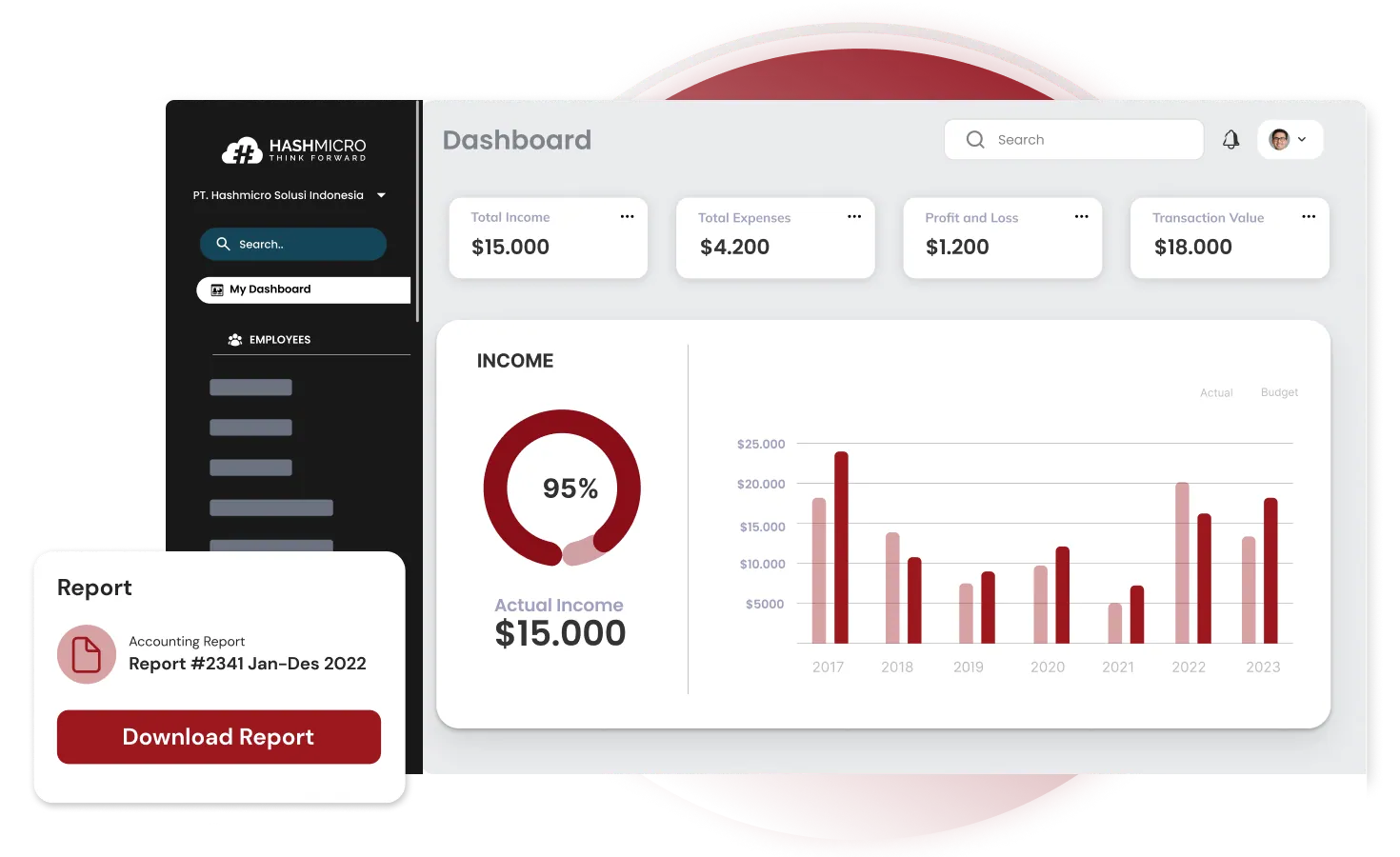The Days Payable Outstanding (DPO) formula calculates accounts payable by the cost of goods sold (COGS) and multiplies the result by the number of days in the analysed period. This formula provides businesses with insights into their payment practices.
In 2023, DPO across industries fluctuated, sharply declining in Q4 2019. This reflects businesses tightening payment terms in response to economic uncertainty. An effective accounting system can help manage these changes by automating financial processes
An accounting system can improve DPO by automating financial processes such as invoice management, accounts payable, and vendor payments. This automation enhances the accuracy and timeliness of payments, reducing the risk of delays.
This article will explore the DPO formula, discuss its importance in cash flow management, and explore how an accounting system can effectively improve DPO. By bridging these concepts, businesses can better manage their financial operations.
Table of Content:
Table of Content

Key Takeaways
|
What is the Days Payable Outstanding Formula?
The Days Payable Outstanding (DPO) formula is a key indicator of a company’s payment cycle and overall cash flow management. It measures the average days a business takes to pay its suppliers for goods or services received.
This metric is important because it helps businesses understand how efficiently they manage their accounts payable. By optimizing DPO, companies can balance holding onto cash for as long as possible and ensuring they pay suppliers promptly to avoid damaging relationships.
The days payable formula is calculated by dividing the total accounts payable by the cost of goods sold (COGS), and then multiplying the result by the number of days in the period under analysis. Accounts payable represents the amount a business owes to its suppliers, while COGS reflects the direct costs of producing the goods or services sold.
A high DPO means that a company takes longer to pay its suppliers, which can be an advantage in cash flow management, as it keeps cash in the business longer. However, if the DPO is too high, it could strain supplier relationships, potentially leading to delays in receiving goods or services or harming the company’s reputation.
Conversely, a low days payable outstanding formula indicates quicker supplier payments, which could strengthen relationships and lead to cash flow challenges if not managed properly.
Why Days Payable Outstanding (DPO) Matters for Financial Health
Days Payable Outstanding (DPO) is a critical metric for assessing a company’s financial health and operational efficiency. It measures the average days a business takes to pay its suppliers after receiving goods or services.
Days payable outstanding formula plays a vital role in understanding how effectively a company manages its cash flow, which is essential for sustaining operations, meeting obligations, and investing in growth.
A well-managed DPO allows companies to maximize their liquidity. Businesses can retain cash longer and allocate it to other operational needs by strategically extending payment terms without jeopardising supplier relationships.
On the other hand, maintaining a balanced DPO is equally essential. If a company’s DPO is too high, it may signal potential risks such as strained supplier relationships, leading to delays in the supply chain or loss of favourable terms.
Conversely, a very low day payable might indicate that the company is not taking full advantage of credit terms offered by suppliers, potentially missing opportunities to improve cash flow.
Days payable outstanding formula matters because it reflects a company’s ability to manage its financial obligations and maintain healthy supplier relationships.
How to Calculate Days Payable Outstanding (DPO) Using the Formula
Calculating Days Payable Outstanding (DPO) is a straightforward process that provides valuable insights into how efficiently a business manages its payment cycle.
The days payable outstanding formula helps determine the average days a company takes to pay its suppliers, allowing businesses to optimize their cash flow and maintain a healthy financial balance.
- Accounts payable is the total amount a company owes to suppliers for goods or services purchased but not yet paid for.
- Cost of Goods Sold (COGS) represents the direct costs associated with producing goods or services the company sells.
- Number of days typically refers to the period being analyzed, such as 365 days for a year or 90 days for a quarter.
Below are the days payable outstanding examples. If a company has $500,000 in accounts payable, $2,000,000 in COGS, and the period being analyzed is 365 days, the DPO calculation would be:
This means the company takes an average of 91.25 days to pay its suppliers.
Understanding this metric allows businesses to evaluate their payment practices. A higher DPO indicates the company is taking longer to pay, which can improve cash flow, while a lower DPO suggests quicker payments.
Regularly calculating days payable outstanding formula helps businesses optimize payment schedules, manage liquidity, and maintain strong supplier relationships.
Comparing DPO with Other Key Cash Flow Metrics
Days Payable Outstanding (DPO) is a critical metric in cash flow management but doesn’t operate in isolation. To comprehensively understand a company’s financial health, DPO should be analyzed alongside other key cash flow metrics such as Days Sales Outstanding (DSO) and Days Inventory Outstanding (DIO).
These metrics provide a broader view of a company’s cash conversion cycle and operational efficiency.
DPO specifically measures how long a company takes to pay its suppliers. In contrast, DSO tracks the average number of days a company takes to collect customer payments, reflecting the efficiency of its accounts receivable process.
A high DSO could indicate slower customer payments, which might strain cash flow, while a low DSO suggests faster collections. Balancing DSO with DPO is crucial to maintaining healthy cash flow.
Analyzing DPO alongside DSO and DIO provides a more holistic view of a company’s cash flow dynamics. This combined analysis can help businesses identify potential inefficiencies, improve liquidity, and maintain a balanced cash conversion cycle.
Practical Tips for Managing and Improving Days Payable Outstanding
By optimizing payment cycles, businesses can achieve a balance between retaining liquidity and meeting financial obligations. Here are practical tips for managing and improving your DPO:
1. Negotiate favorable payment terms
Work closely with your suppliers to negotiate extended payment terms without straining the relationship. Establishing clear communication and demonstrating reliability as a customer can help secure terms that give you more flexibility in managing outgoing payments.
2. Leverage technology for payment automation
Invest in software solutions like accounting systems or HRM platforms that automate payment schedules. Automated systems help ensure timely payments, reduce the risk of errors, and streamline accounts payable processes, all of which contribute to better DPO management.
3. Monitor and analyze DPO regularly
Track your DPO consistently to identify trends and areas for improvement. Compare it with industry benchmarks and other cash flow metrics to assess your company’s financial health. This regular review allows you to make informed decisions about payment strategies.
4. Optimize inventory and procurement processes
Efficient inventory management and procurement planning can reduce the strain on accounts payable. By aligning inventory turnover with payment cycles, businesses can better coordinate cash inflows and outflows, improving overall DPO performance.
5. Maintain strong supplier relationships
While optimizing DPO, ensure that supplier relationships remain positive. Late payments or overextended terms can harm trust and lead to disruptions in the supply chain. Communicate openly and adhere to agreed payment schedules to foster collaboration.
By implementing these practical tips, businesses can improve their DPO and enhance their overall financial operations, ensuring a balanced approach to cash flow management and supplier engagement.
Optimize DPO Management with HashMicro Accounting System
Managing Days Payable Outstanding (DPO) effectively is crucial for maintaining a healthy cash flow, and having the right accounting system can make all the difference. HashMicro’s Accounting System is designed to help businesses streamline their financial processes, automate payment schedules, and ensure timely payments to vendors.
HashMicro’s automated accounts payable function simplifies invoice management and supplier payment processes. Several features of HashMicro HRM designed to support DPO management include:
- Bank Integration—Auto Reconciliation automatically matches and reconciles bank transactions with accounting records, reducing manual errors and ensuring accurate financial statements.
- Multi-Level Analytical: This method provides an in-depth analysis across multiple levels of financial data, allowing businesses to gain insights into different departments, cost centres, and profit margins.
- Profit & Loss vs Budget & Forecast: Compares actual profit and loss figures with budgeted and forecasted numbers to evaluate financial performance and identify discrepancies.
- Cash Flow Reports: This service generates detailed reports on cash inflows and outflows, helping businesses monitor liquidity and plan for future financial needs.
- Forecast Budget: This projector of future financial conditions based on historical data, market trends, and business plans aids in accurate budget planning.
- Budget S Curve: Visualizes budget progress over time, helping businesses track their spending against planned budgets and forecasted financial goals.
Conclusions
Days Payable Outstanding (DPO) is a crucial financial metric that tracks the average days a company takes to pay its suppliers after receiving goods or services. Effectively managing DPO can improve cash flow and enhance overall financial efficiency.
Optimizing DPO can improve liquidity management, negotiate leverage with suppliers, and create a more balanced cash flow cycle. A well-managed DPO ensures businesses meet their financial obligations without compromising their cash position.
An accounting system HashMicro, can play a key role in improving DPO by automating financial processes such as invoice management, accounts payable, and vendor payments. This automation enhances the accuracy and timeliness of payments, reducing the risk of delays and maintain a positive cash flow.
To streamline your financial operations and improve DPO management, explore HashMicro’s accounting system. Contact us for a free demo and discover how our solution can help optimize your business’s financial performance.
FAQ About Days Payable Outstanding Formula
-
Should DPO be high or low?
Should a company aim for a high or low DPO? From a working capital perspective, a high DPO is advantageous as it allows the company to retain its cash longer before paying suppliers. However, it could also signal potential difficulties in meeting financial obligations promptly.
-
What is a good DPO value?
A DPO ranging from 30 to 45 days is commonly regarded as standard across various industries. However, there is no universal benchmark for DPO, as it can differ significantly depending on the industry, company size, and other influencing factors.
-
What is the difference between days receivable and days payable?
What sets receivable days apart from payable days? Receivable days track how quickly a company collects payments from its customers, whereas payable days indicate the time taken by the company to settle its debts with suppliers.




































